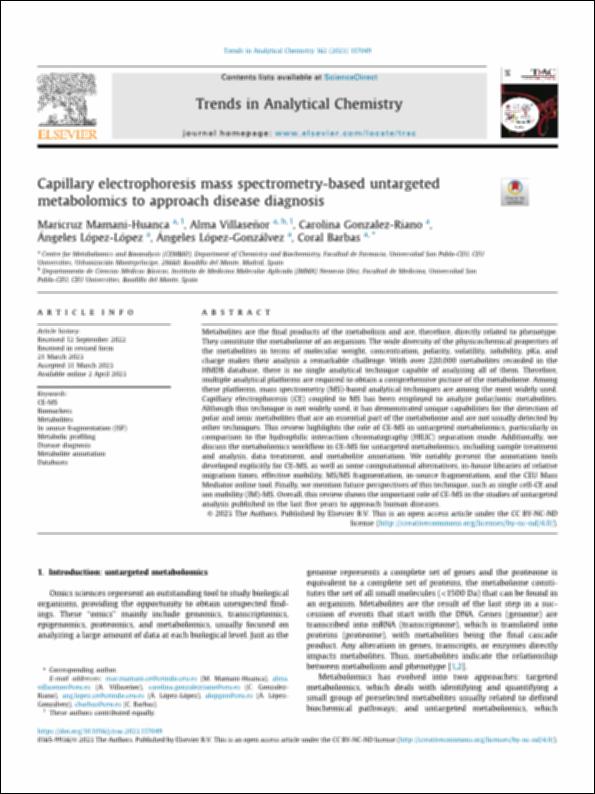Por favor, use este identificador para citar o enlazar este ítem:
http://hdl.handle.net/10637/14205Capillary electrophoresis mass spectrometry-based untargeted metabolomics to approach disease diagnosis
| Título : | Capillary electrophoresis mass spectrometry-based untargeted metabolomics to approach disease diagnosis |
| Autor : | Mamani-Huanca, Maricruz Villaseñor Solis, Alma Cristina González Riaño, Carolina López López, Ángeles Barbas Arribas, Coral. |
| Materias: | CE-MS; Biomarkers; Metabolites; In source fragmentation (ISF); Metabolic profiling; Disease diagnosis; Metabolite annotation; Databases |
| Editorial : | Elsevier |
| Citación : | Maricruz Mamani-Huanca, Alma Villaseñor, Carolina Gonzalez-Riano, Ángeles López-López, Ángeles López-Gonzálvez, Coral Barbas, Capillary electrophoresis mass spectrometry-based untargeted metabolomics to approach disease diagnosis, TrAC Trends in Analytical Chemistry, Volume 162, 2023, 117049, ISSN 0165-9936, https://doi.org/10.1016/j.trac.2023.117049 |
| Resumen : | Metabolites are the final products of the metabolism and are, therefore, directly related to phenotype. They constitute the metabolome of an organism. The wide diversity of the physicochemical properties of the metabolites in terms of molecular weight, concentration, polarity, volatility, solubility, pKa, and charge makes their analysis a remarkable challenge. With over 220,000 metabolites recorded in the HMDB database, there is no single analytical technique capable of analyzing all of them. Therefore, multiple analytical platforms are required to obtain a comprehensive picture of the metabolome. Among these platforms, mass spectrometry (MS)-based analytical techniques are among the most widely used. Capillary electrophoresis (CE) coupled to MS has been employed to analyze polar/ionic metabolites. Although this technique is not widely used, it has demonstrated unique capabilities for the detection of polar and ionic metabolites that are an essential part of the metabolome and are not usually detected by other techniques. This review highlights the role of CE-MS in untargeted metabolomics, particularly in comparison to the hydrophilic interaction chromatography (HILIC) separation mode. Additionally, we discuss the metabolomics workflow in CE-MS for untargeted metabolomics, including sample treatment and analysis, data treatment, and metabolite annotation. We notably present the annotation tools developed explicitly for CE-MS, as well as some computational alternatives, in-house libraries of relative migration times, effective mobility, MS/MS fragmentation, in-source fragmentation, and the CEU Mass Mediator online tool. Finally, we mention future perspectives of this technique, such as single cell-CE and ion mobility (IM)-MS. Overall, this review shows the important role of CE-MS in the studies of untargeted analysis published in the last five years to approach human diseases. |
| URI : | http://hdl.handle.net/10637/14205 |
| Derechos: | http://creativecommons.org/licenses/by-nc-nd/4.0/deed.es openAccess |
| ISSN : | 0165-9936 |
| Cubierto por: | Acuerdo Transformativo - 2023 |
| Fecha de publicación : | 17-abr-2023 |
| Centro : | Universidad San Pablo-CEU |
| Aparece en las colecciones: | Facultad de Farmacia |
Los ítems de DSpace están protegidos por copyright, con todos los derechos reservados, a menos que se indique lo contrario.


